On the heels of my Voronezh review, here’s my take on the Bulava steak, aka tomahawk. Since I suggested that Voronezh should try creating a genuinely Russian steakhouse not only with the meat it serves, but also in the sides and accompaniments, I figured I should give it a go myself.
I can think of many sides with Russian flavors that would go nicely with steak: sautéed shredded cabbage, a warm beet salad, a pumpkin gratin, roasted root vegetables… But for today, I’ve picked three very Russian ingredients:
- Buckwheat. Kasha is the quintessential slavic food: in the Middle Ages, it was often cooked for weddings, the signing of peace treaties, and the feasts of the nobility, and eventually became an everyday meal for the common man. Note that in Russia, kasha is made from pretty much any cereal, and can be savory or sweet. I didn’t have to think too hard about this one, as Voronezh already offers a buckwheat kasha with porcini and onion. My version is prepared with dried porcini and dried cranberry, and of course butter, like any self-respecting kasha.
- Potato. Conveniently, steak’s best companion is also a staple of Russian cuisine. Thinking about it now, I could have gone for something traditional, such as deruny / draniki, or potato latkes – should you choose to go that route, the recipes are here and here. Instead, I’m preparing an aligot, a French potato purée mixed with a generous amount of cheese (my recipe is adapted from Serious Eats). I think it’s quite appropriate, since Russia is currently going through a cheese frenzy. Because of The Sanctions, the Russian dairy industry has undertaken to create domestic versions of those beloved French and Italian cheeses that are now banned. When I write a post about Moscow’s markets in the coming weeks, you’ll see Russian camembert, raclette, and taleggio. I find that raclette’s strong flavor is a good contender to stand up to the the tomahawk.
- Onion – or scallion, in this case. Remember LavkaLavka’s menu, where onion is mentioned ten times? I love cooking whole scallions or spring onions on the grill, and since we’re already firing up the grill for the steak…
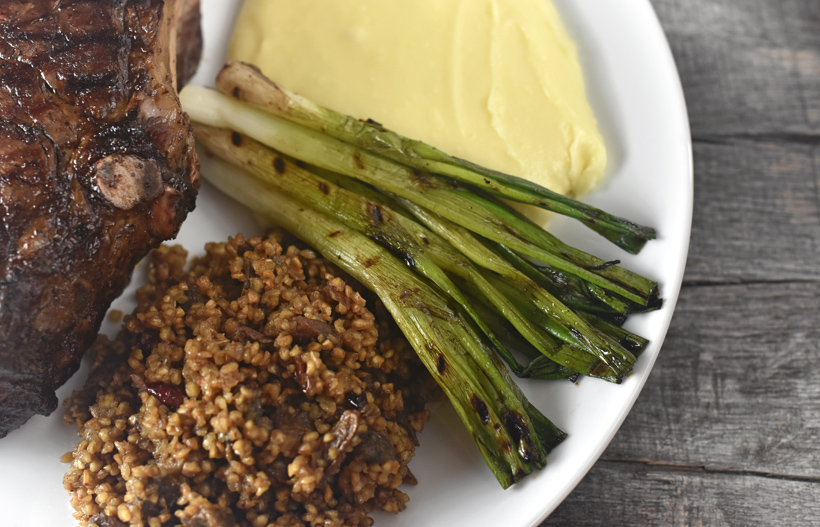
Finally, even if I don’t think a good steak needs any kind of sauce, I never say no to butter. I’m making a classic beurre maître d’hôtel, because it actually brings something to the dish: the lemon juice cuts through the richness of the meat a little, and the parsley add some mild herbal notes.
The recipe is written to produce a steak that I would consider to be cooked rare, though nowadays everyone seems to come with their own definitions of meat doneness. The tomahawk, which I purchased from Snake River Farms, makes 2 to 3 copious servings. However, most of the proportions below yield 4 servings, as making the whole dish would sure be a lot of effort for just 2 servings. Anyway, the kasha and aligot make excellent leftovers. If you have a party of four people, you might as well serve a second steak, maybe a thick Chateaubriand (cooked the same way) to enjoy the contrast between the two cuts – the tenderloin is less flavorful but more tender. The beef stock below is scaled to 8 servings, simply because I’ve never heard of anyone making a batch of 150 g (less than a cup) of beef stock!
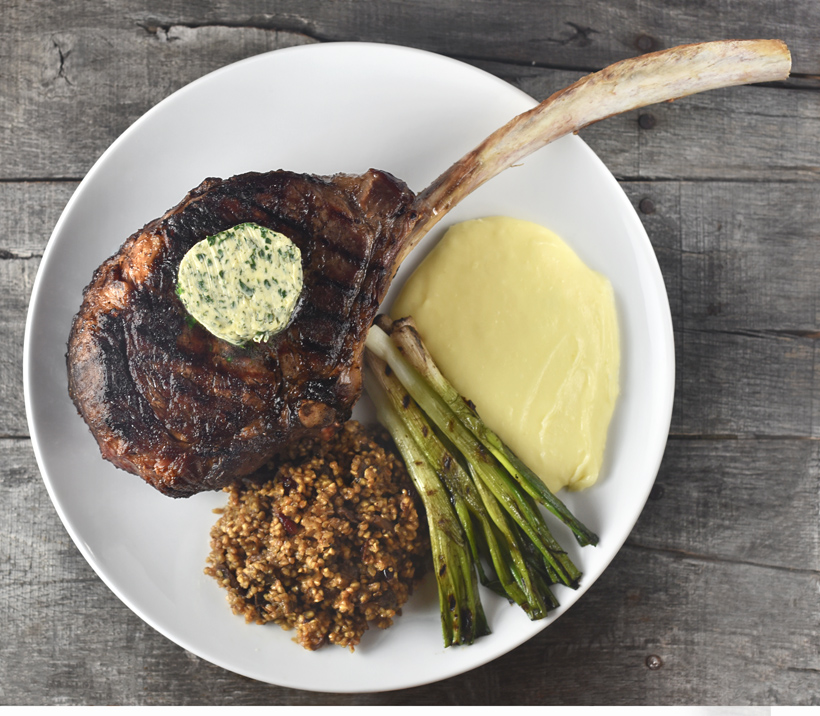
Beef stock
Yields about 600 g (8 servings)
10 g canola oil
400 g beef bones
75 g peeled carrots, large dice
75 g celery, large dice
150 g peeled onion, large dice
salt
150 g red wine
5 thyme sprigs
1 parsley sprig
550 g water
- Heat the oil in the pot of a pressure cooker over high heat. Add the beef bones, carrots, celery, and onion, and sauté until the vegetables start to color, stirring regularly.
- Season with salt, add the red wine, and cook until the wine has reduced by about half.
- Add the thyme, parsley, and water. Cover, bring to pressure, and cook under pressure for 1 hour.
- Let cool for 30 minutes, then pass through a chinois, discarding the solids. Transfer the stock to a quart container, and refrigerate for at least 12 hours.
- Once cold, remove and discard the congealed fat from the surface.
Beurre maître d’hôtel
Yields 4 servings
100 g butter, diced and softened
10 g parsley leaves, very finely chopped
10 g lemon juice
1.5 g salt
0.1 g black pepper, ground
- Place the butter, parsley, lemon juice, salt and pepper in a bowl, then combine with a fork.
- Transfer the compound butter to a sheet of plastic film, and tightly wrap into a log. Refrigerate for at least 1 hour.
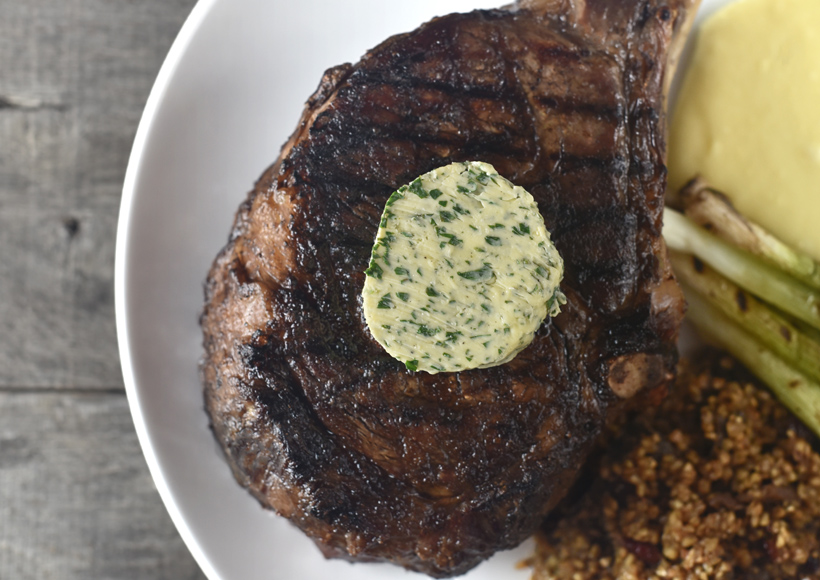
Bulava Steak
Yields 2-3 servings
1 tomahawk ribeye steak, about 1200 g, 6-7 cm thick
6 g salt
canola oil
6 g smoked salt
30 g butter, sliced
- Season the steak with the regular salt on all sides.
- Heat a grill (outdoor grill or grill plate on the stovetop) to the highest possible temperature. Brush with canola oil, and sear the steak on both sides until brown.
- Season the steak with the smoked salt on all sides, transfer to an oven dish, and place the butter slices on top. Cook in a 95 C / 200 F oven for about 1 hour, until the internal temperature of the meat reaches 49 C / 120 F in the center (for a steak cooked rare) – the duration is approximate; what really matters is the internal temperature.
- Transfer to a plate, and let rest for 5-10 minutes, until you’re ready to proceed with the assembly steps.
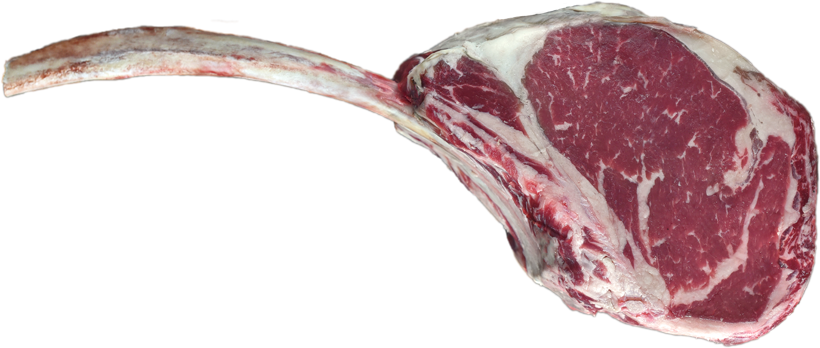
Aligot
Yields 4 servings
315 g peeled Yukon Gold potatoes, peeled and cut into 3 cm chunks
1 peeled garlic clove
1 thyme sprig
salt
55 g butter, diced
110 g heavy cream
135 g raclette cheese, grated
- Place the potatoes, garlic, and thyme in a large saucepan filled with salted water. Bring to a boil over high heat, then reduce the heat to medium-low, and simmer for about 20 minutes, until the potatoes are tender.
- Discard the thyme, drain the potatoes and garlic in a colander, then purée using a ricer or food mill fitted with the finest disk. Return to the saucepan, and mix in the butter.
- Set the saucepan over low heat, add the cream, and stir well. Continue stirring and working potatoes with a rubber spatula for about 3 minutes, until potato mass feels thickened and sticky.
- Add the grated cheese in small batches, stirring between each addition. Season with salt if needed. Continue stirring about 3 minutes longer, until the mixture becomes thick, smooth, and elastic (do not worry about overworking the potatoes, since you want to develop that starch). The aligot should form long, stretchy strands when you lift it from the pot. Cover and reserve.
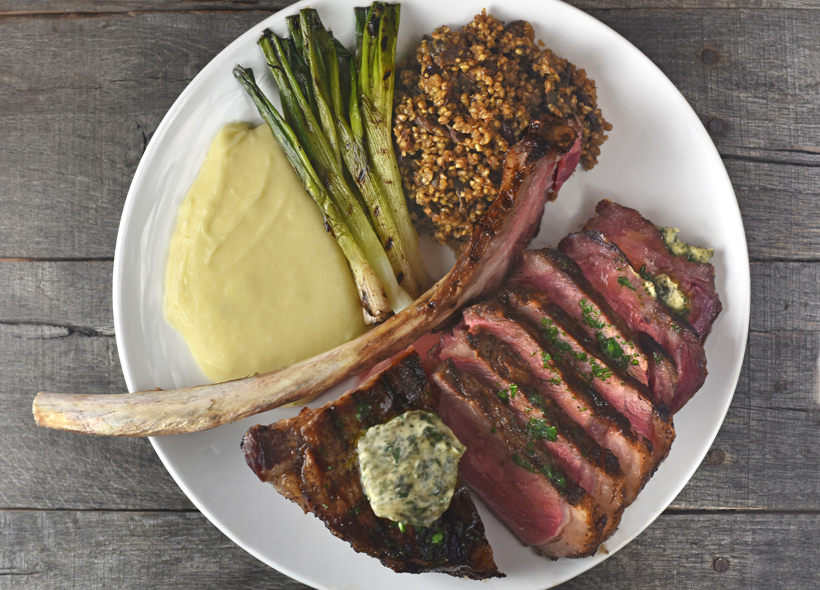
Cranberry and porcini kasha
Yields 4 servings
280 g beef stock
25 g dried cranberries
20 g dried porcini, chopped
20 g (about 1/2) egg
90 g buckwheat
15 g shallots, minced
25 g butter
salt
black pepper, ground
- Bring the beef stock with the dried cranberries and porcini to a boil in saucepan over high heat. Reserve.
- Lightly beat the egg in a bowl. Add the buckwheat, and stir to coat the grains.
- In a saucepan over medium heat, sauté the shallots in half of the butter until soft. Add the buckwheat, and cook over high heat for 2-3 minutes, stirring constantly, until the grains are separated.
- Add the beef stock mixture to the kasha, then simmer over low heat for about 10 minutes, until tender.
- Stir in the remaining butter, season with salt and pepper, and reserve.
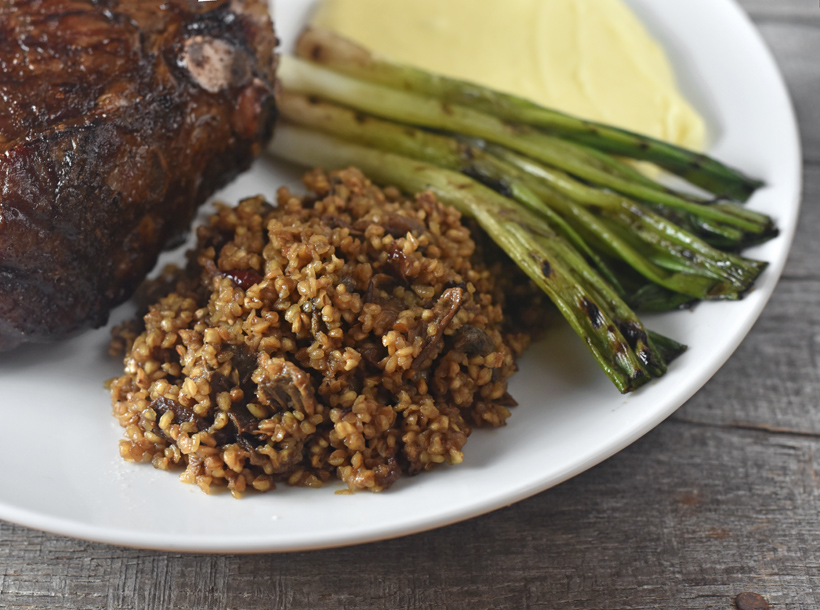
Assembly
Yields 4 servings
8 scallions
salt
canola oil
bulava steak (plus another smaller, similarly prepared steak, to make 4 servings)
black pepper, ground
beurre maître d’hôtel
aligot
cranberry and porcini kasha
- Trim the bottoms and the green parts of the scallions, and season with salt.
- Reheat the grill to the highest possible temperature, and brush with canola oil. Grill the scallions on both sides until tender, and reserve.
- Sear the steak briefly on both sides to brown it some more (maybe 30 seconds on each side, twice). Let rest on a plate or cutting board for a couple minutes, and season with pepper. You can either serve the steak whole, or cut off the bone and slice the meat. Either way, top with slices of beurre maître d’hôtel.
- Reheat the aligot and the kasha over medium heat, and serve on the side with the scallions.
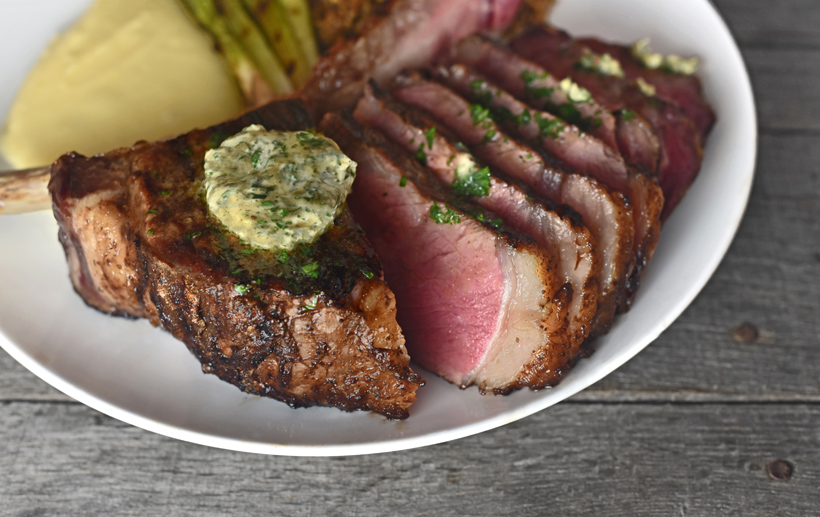

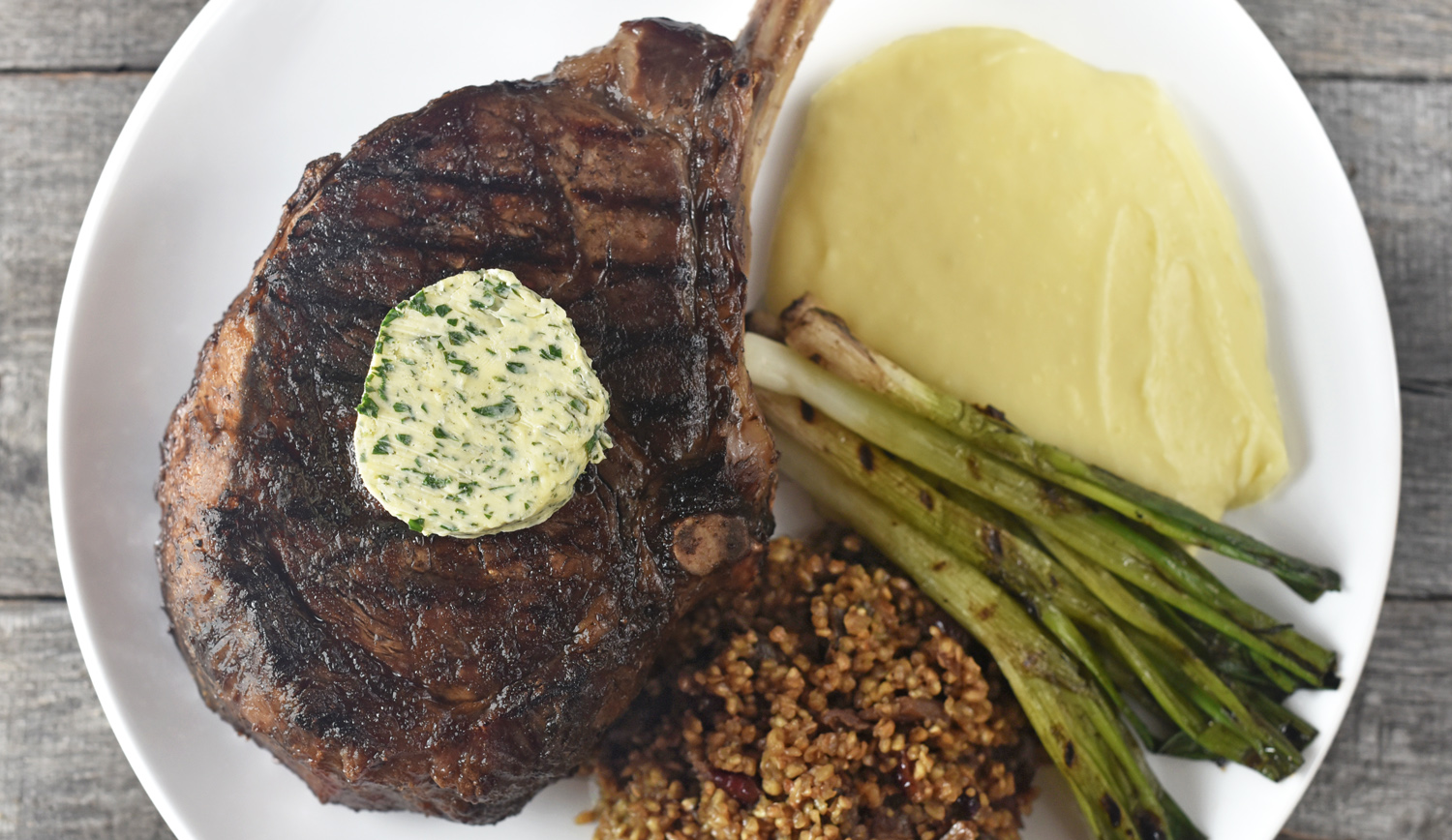
1 comment
good job!! nice recpie